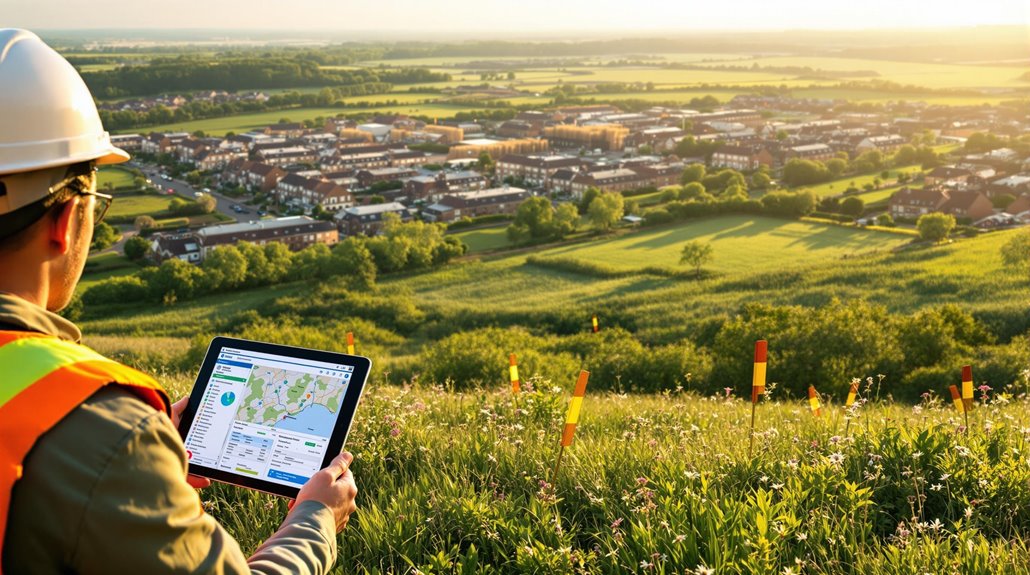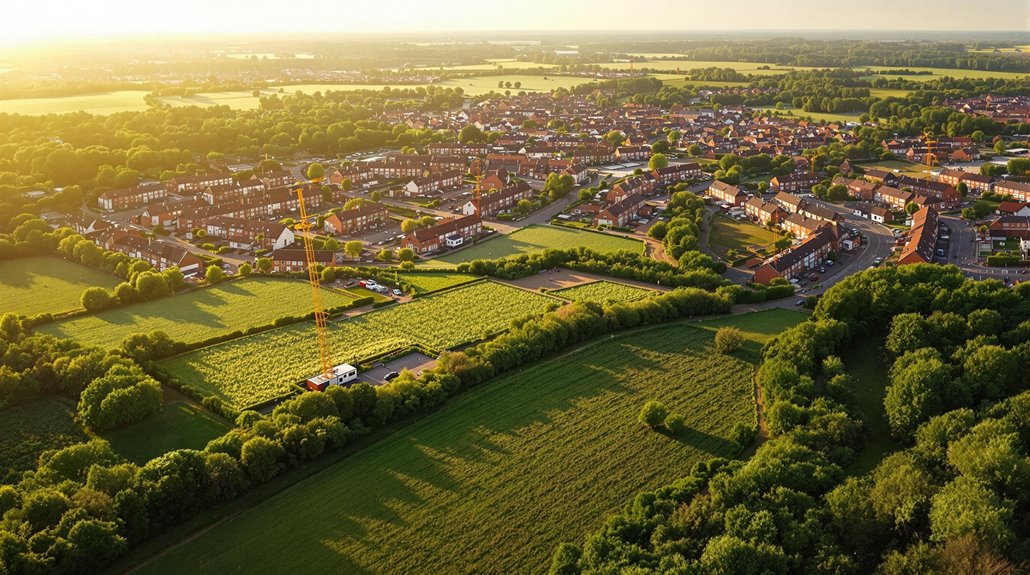I’ve been tracking the rollout of Biodiversity Net Gain rules since their February 2024 launch, and I can tell you they’re fundamentally changing how developers approach project budgets and timelines. If you’re planning any development work in the UK, you’ll need to factor in this mandatory 10% biodiversity enhancement from day one—it’s not optional anymore. The financial implications alone will reshape your entire planning process, and there’s more complexity ahead than most realize.
Key Takeaways
- Property developers must achieve minimum 10% biodiversity uplift on developments, calculated using official metrics since February 2024.
- BNG requirements increase development costs by 5-15% and extend project timelines by 3-6 months due to compliance needs.
- Developers must conduct front-loaded ecological surveys and redesign layouts to minimize footprints and preserve green corridors early.
- BNG creates £135-274 million annual market where developers purchase biodiversity units from habitat banks when on-site gains insufficient.
- Enhanced habitats must be legally maintained for 30 years, with qualified ecologists required to verify compliance calculations.
Understanding the 10% Biodiversity Enhancement Requirement
Since February 12, 2024, England’s property developers must deliver a minimum 10% biodiversity uplift on most new developments—a requirement that’s reshaping project budgets and timelines across the industry.
I’ll help you understand what this means for your projects. The 10% isn’t calculated on gut feeling—it’s measured using the official Biodiversity Metric, which assigns scores based on habitat distinctiveness, condition, and strategic significance. You’ll compare your site’s pre-development score against what you’re creating post-development.
Here’s what you need to know: 10% is the floor, not the ceiling. Local authorities can demand higher percentages, and you’ll want to plan accordingly. The enhancement focuses on habitat quality improvements rather than simply expanding areas, so strategic habitat selection becomes vital for cost-effective compliance. Any created or enhanced habitats must be maintained for a minimum 30 years under legal agreements that outline management responsibilities.
Timeline and Phased Implementation Across Development Types
After multiple delays pushed back the original November 2023 launch date, England’s Biodiversity Net Gain requirements rolled out in phases starting February 12, 2024.
I’ll break down how this staggered implementation affects your development timeline. Major developments faced the first wave on February 12th, requiring immediate 10% biodiversity enhancement compliance. You’ll need to factor this into your project budgets and planning applications right away.
Small sites caught up quickly on April 2, 2024, bringing minor developments under the same 10% requirement. This means virtually all residential and commercial projects now need biodiversity calculations.
Nationally Significant Infrastructure Projects will join the mandatory framework on November 12, 2025. If you’re planning large-scale infrastructure, you’ve got breathing room to prepare your biodiversity strategies and budget accordingly.
The government has committed over £15 million to help Local Planning Authorities navigate these new requirements and ensure smooth implementation across all development sectors.
Measuring Biodiversity Value Through DEFRA’s Statutory Metric

While England’s phased rollout sets the compliance dates, you’ll need DEFRA’s Statutory Metric to actually prove your project delivers the required 10% biodiversity enhancement. I’ll walk you through this free tool that’s become essential for our industry.
The metric calculates biodiversity units by weighing habitat distinctiveness, condition, and size. You’ll multiply these by connectivity factors and strategic significance ratings. Think of it as your biodiversity accounting system—converting complex ecosystems into tradeable units.
Start with baseline habitat surveys before development, then compare against post-development projections using DEFRA’s approved spreadsheet. You’ll need qualified ecologists to verify your inputs, but the tool itself guides you through each calculation step, ensuring you meet planning requirements while managing offset costs effectively. The tool should be used repeatedly during design and planning to maximize on-site gains before considering off-site options.
How BNG Is Reshaping Planning and Design Processes
BNG requirements aren’t just adding another compliance box to tick—they’re fundamentally restructuring how you’ll approach every development from initial site assessment through long-term maintenance. You’ll now conduct front-loaded ecological surveys before finalizing masterplans, redesigning layouts to minimize building footprints and preserve green corridors. Your planning applications must include detailed BNG delivery plans showing how you’ll achieve that mandatory 10% net gain through onsite innovations like green roofs or offsite habitat restoration contracts. It’s crucial to ensure that these changes align with approved planning permissions to avoid potential legal repercussions.
You’ll weigh cost-benefit analyses comparing design adjustments against expensive statutory credits—green roofs versus habitat banking fees. Phased construction becomes essential, with habitat creation preceding building work. Digital mapping tools help model biodiversity impacts during planning, while contractor training guarantees your supply chains understand habitat-sensitive methods throughout the 30+ year monitoring period. Natural England’s Biodiversity Metric tool will become integral to your planning process, helping you accurately measure habitat quality changes and demonstrate compliance with BNG requirements.
The Emerging Biodiversity Credits Market and Economic Impact

Beyond compliance requirements, BNG is creating an entirely new financial ecosystem that’ll directly impact your development budgets and project timelines. You’re now operating within a market where biodiversity units cost real money—DEFRA estimates the off-site market at £135-274 million annually.
When you can’t achieve 10% net gain on-site, you’ll need to purchase units from habitat banks or Natural England’s statutory credits as a last resort. This isn’t theoretical—developers have already spent £247,416 on statutory credits in the first year alone.
Here’s what matters for your bottom line: habitat banks are generating competitive pricing, while DEFRA deliberately marks up statutory credits to push you toward private providers. You’ll want to factor these costs into early project budgets and explore partnerships with habitat banks to secure better rates. The government expects to spend around £300,000 in the upcoming financial year as the statutory credits income reaches sufficient levels for meaningful habitat investment.
Challenges Facing Developers and Future Policy Developments
Unless you’ve got deep pockets and unlimited time, BNG’s implementation challenges will test your project management skills and financial reserves. You’ll face 5-15% cost increases, 3-6 month timeline extensions, and 30-year liability commitments that’ll strain your cash flow and boost insurance premiums.
The expertise shortage hits hard—qualified ecologists are scarce, planning officers need training, and Local Planning Authorities interpret the 10% requirement differently. If you’re a smaller developer, you’ll feel these resource gaps more acutely than your larger competitors.
However, relief’s coming. Government consultations are simplifying rules for minor developments and brownfield sites. Digital platforms will streamline biodiversity unit trading, while automated metric tools reduce errors. Smart developers are already adopting pre-application assessments and partnering with conservation groups to stay ahead. The consultation feedback deadline of 11:59pm on 24 July 2025 gives stakeholders a clear timeframe to influence these proposed improvements.
Conclusion
BNG rules fundamentally change how you’ll approach property development. I recommend building biodiversity costs into your budgets now—expect 2-5% increases. Start using DEFRA’s metric early in planning to avoid costly redesigns. Consider partnering with habitat banks for cheaper credits than on-site delivery. Monitor policy updates closely as enforcement tightens. Success depends on integrating ecological planning from day one, not treating it as an afterthought that’ll drain your profits.
References
- https://www.bng.ai/blog/the-ultimate-guide-to-biodiversity-net-gain-a-2025-perspective/
- https://www.gov.uk/guidance/understanding-biodiversity-net-gain
- https://www.hoganlovells.com/en/publications/biodiversity-net-gain-in-the-uk-a-year-on
- https://www.gov.uk/government/collections/biodiversity-net-gain
- https://beale-law.com/article/biodiversity-net-gain-celebrating-one-year-of-the-landmark-environmental-policy-for-new-developments-in-england/
- https://www.gov.uk/guidance/biodiversity-net-gain
- https://www.joesblooms.com/blog/what-actually-counts-towards-your-10-uplift-in-biodiversity-net-gain
- https://www.tetratecheurope.com/news/biodiversity-net-gain-legislation-what-you-need-to-know/
- https://www.aaronandpartners.com/news/what-is-the-10-biodiversity-net-gain-requirement/
- https://www.gov.uk/government/news/biodiversity-net-gain-moves-step-closer-with-timetable-set-out

